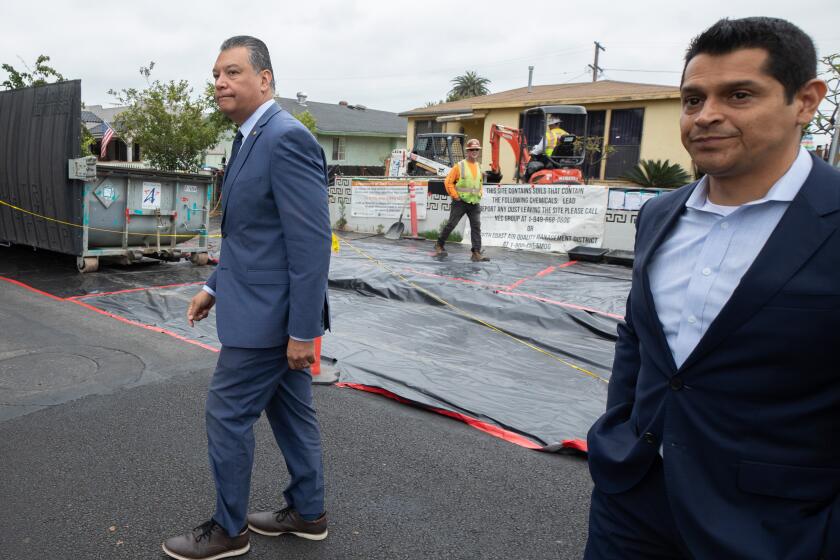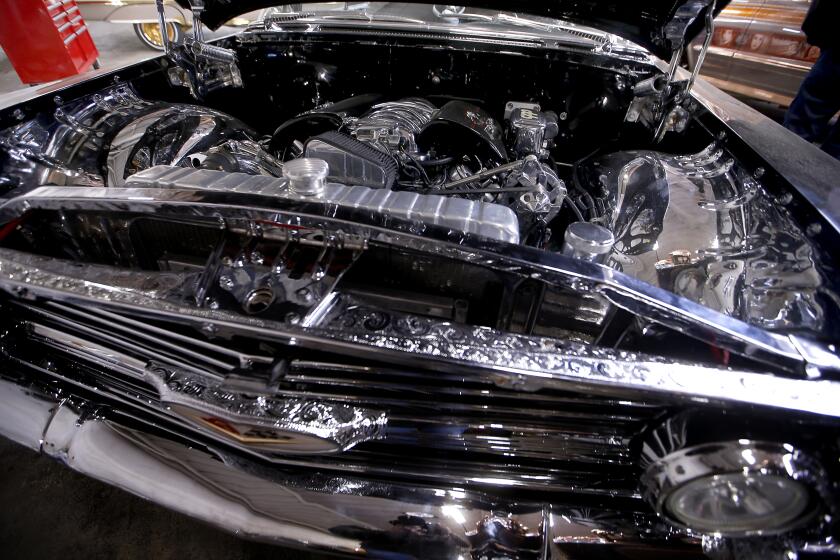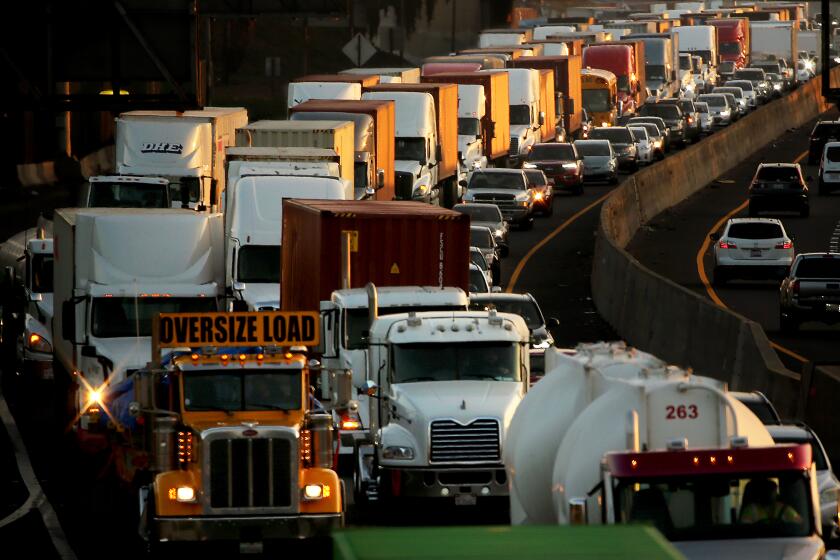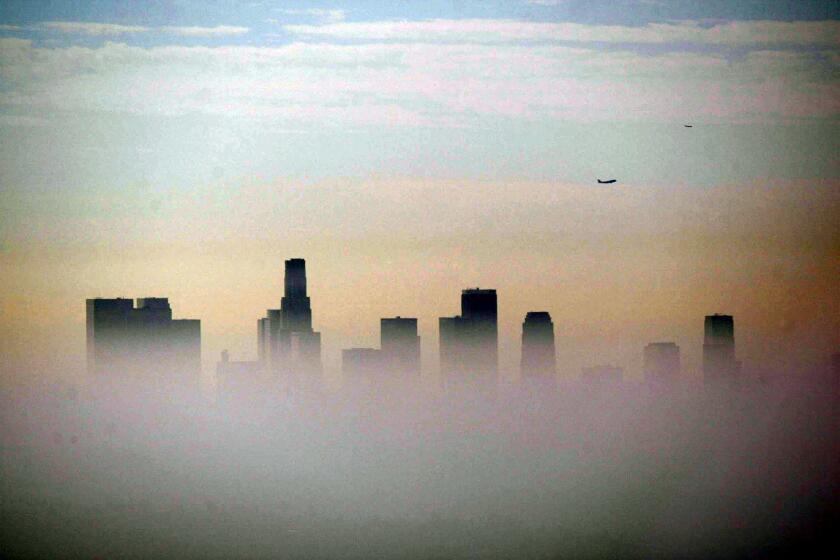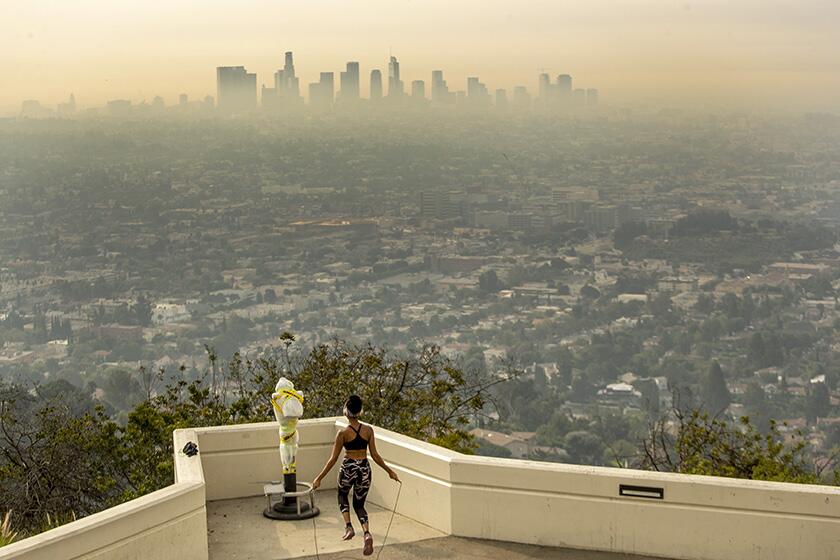
- Share via
If there’s anything I’ve learned after covering air quality in California for the last year, it’s that there is no fundamental right to clean air.
In my short time in Los Angeles, I’ve seen mountain ranges disappear behind a veil of lung-searing smog. I’ve seen an armada of diesel-belching freighters — each the length of a city block — congregating around the ports as they wait to unload. I’ve witnessed an endless procession of trucks rumble through the Inland Empire.
For the record:
3:35 p.m. Aug. 31, 2023A previous version of this story erroneously stated the ports of Long Beach and Los Angeles pledged to transition to zero-emission ships by 2030. Port officials have made no such commitment. The city councils of these cities passed resolutions calling on top importers to make that promise.
The harsh reality is, there are few havens from air pollution in Southern California, and very few people even know where to begin as they search for a place to live. That included me, before my cross-country move from Chicago.
When I began hunting for an apartment in Los Angeles, I found myself flummoxed. How was I supposed to find a pocket of clean air in one of the most polluted air basins in the nation?
He met with residents who live near the former Exide battery plant and called for federal Superfund status.
I realized that if I wanted to protect my health, I needed to quickly educate myself on the region’s largest polluters, its many microclimates and its topography.
This research would profoundly change the way I see and navigate Los Angeles.
My first step was to pore over books written by doctors and scholars to learn why lung health is so critical. I learned that the average person takes 20,000 breaths a day. This air travels into our lungs and hops aboard our blood cells and courses through our veins to deliver oxygen throughout our bodies, including to the heart and brain.
It became apparent that the air we breathe — including smog, soot and heavy metals — imperceptibly shapes our identities. Those components have the potential to determine how long we live, the limits of our intelligence, the extent of our physical abilities, our reproductive fertility and even our mental acuity as we age.

But why was the air so exceptionally poor in my newly adopted home?
The truth is, Los Angeles is in many ways a victim of success.
If the Golden State is going to lead the world toward a better, safer future, our political and business leaders — and the rest of us — will have to work harder to rewrite the California narrative. Here’s how we can push the state forward.
It’s the country’s second-largest city, but with 6 million cars it has gained notoriety for its congested highways. Its bustling economy results in ample truck, train and ship traffic at its busy ports and rail yards. Its perennially sunny climate cooks vehicle exhaust and other pollution into lung-damaging smog. And the wondrous mountain ranges bordering the region confine this haze over the region.
Since its first major smog outbreak in 1943, California has become a leader in clean air and climate policy.
Yet, even despite its progress, Greater Los Angeles still is the nation’s smoggiest region — and that’s only one pollutant to keep in mind.
Here are a few facts to consider when you’re looking for a place to live.
California air regulators have voted to phase out the use of a highly toxic metal that’s commonly used to restore classic cars and protect aviation parts.
Stay away from freeways
An environmental activist discusses how convenience for drivers comes at a cost for those living close to freeways.
Highways are, in effect, conduits for lung-irritating pollution from vehicle exhaust. Even electric vehicles produce toxic particles from metallic brake and rubber tire wear, so these corridors will continue to be a source of pollution beyond the transition to zero-emission vehicles.
Health officials recommend living at least 1,000 feet away from freeways, but huge swaths of the population have had no say in the matter. Historically many of the nation’s highways have bisected communities of color, placing them next to major sources of pollution.
Chinatown and Boyle Heights, two communities hemmed in by a tangle of large freeways, endure among the highest levels of pollution and have fought against expansion.
Valleys are where smog builds up
As a lifelong Midwesterner, I must admit, air quality was something I rarely thought about. That’s not to say I hadn’t experienced pollution — I had. But my surroundings were always flat.
In a marathon two-day hearing, the California Air Resources Board voted on new regulations designed to limit pollution from locomotives and cargo trucks.
California’s inland valleys are bowls of hot and stagnant air, beyond the reach of cool, ocean breezes that would clear out contaminants. Instead, the mountain ranges that encircle these low-lying areas obstruct air flow, allowing pollution to build up.
Valleys are also some of the hottest and driest regions in California, acting like Dutch ovens, where punishing sunlight and desert heat radiate off the arid landscape.
This sunlight and heat promote chemical reactions. On sunny, hot days, pollution from tailpipes and smokestacks — dangerous by itself — is baked into lung-searing ozone (a.k.a. smog).
It’s no coincidence that San Bernardino County, a hub of logistics centers and warehouses tucked inside a hot valley, was named the smoggiest county in the nation in the American Lung Assn.’s most recent State of the Air report card. Between 2019 and 2021, the county experienced an average of 177 days of unhealthy ozone days.
Ports are filled with diesel exhaust
The twin ports of Los Angeles and Long Beach — the nation’s largest seaport complex — are the primary gateways of trans-Pacific trade, accepting roughly 40% of the nation’s containerized imports.
The port complex is also the largest fixed source of smog-forming pollution in Southern California, due to the fumes emanating from ocean-faring ships, big rig trucks, locomotives and forklifts. But perhaps of greater consequence, most of these run on diesel-powered engines that also produce carcinogenic exhaust.
Around 38.5 million California residents live in a county that received a failing grade in the Lung Assn.’s annual “State of the Air” report.
The city councils of Los Angeles and Long Beach have passed resolutions calling on top maritime importers to transition to zero-emission ships by 2030. But no such ships currently dock at the ports. In the meantime, you can sometimes see barges with long cylindrical tubes, informally called “sock on a stack,” which are fitted overtop a ship’s exhaust to capture a ship’s diesel exhaust.
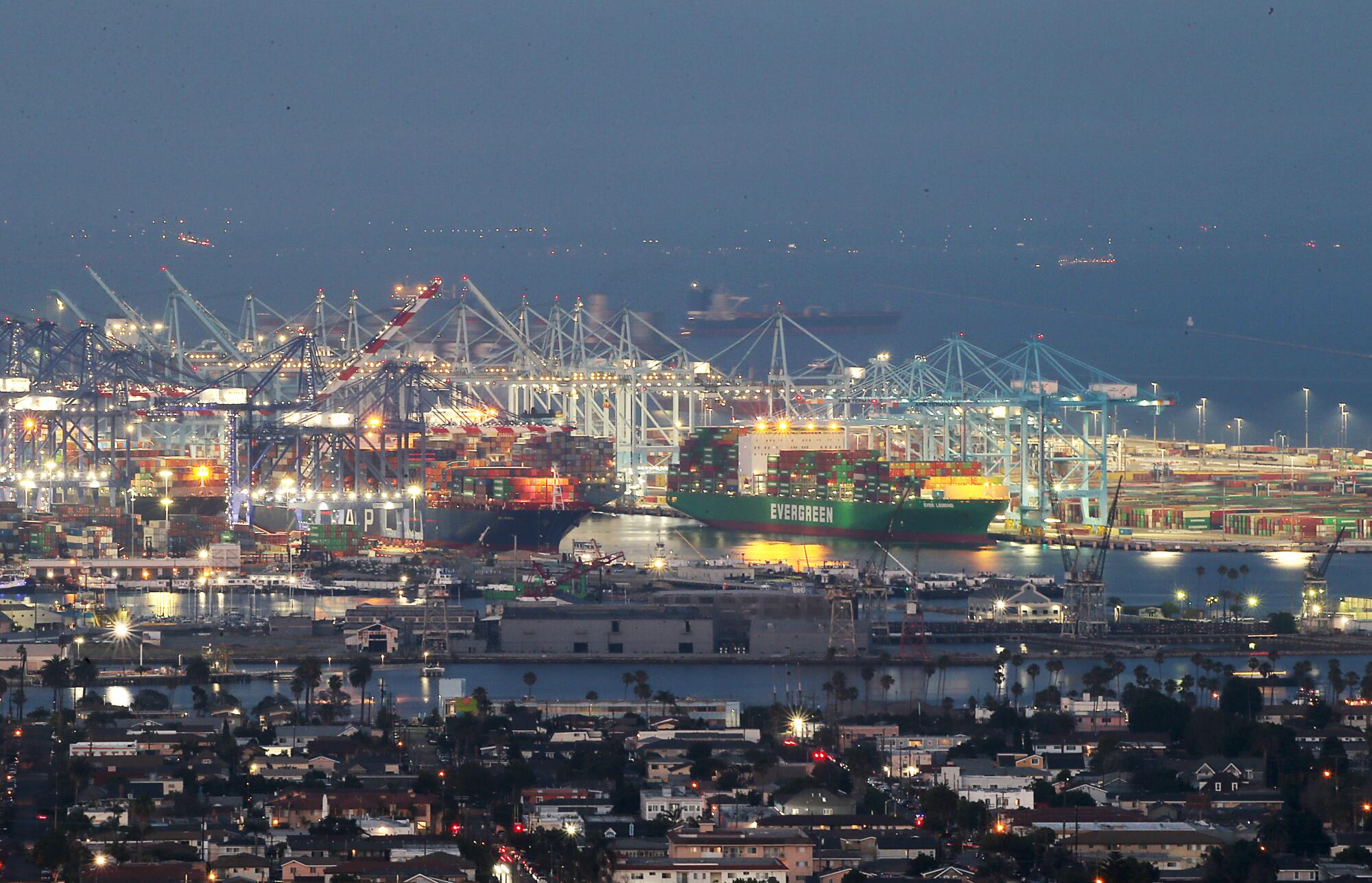
Ports also encourage ships to plug into the onshore power grid to avoid burning diesel while docked. But that protocol has been waived, at times, during heat waves when local power grids are strained.
Oil wells are hidden hazards
Decades ago, it was impossible to ignore the presence of the petroleum industry in Southern California. Rows of towering oil derricks were located anywhere you can imagine — in backyards, in parks and near the shoreline of Huntington Beach.
Today, Los Angeles is still pocked by thousands of oil wells — some active, some plugged and some abandoned and unplugged.
Regardless of status, these wells have been known to leak flammable methane or harmful toxic substances that evaporate easily, including benzene, a carcinogen with no safe level of exposure.
The general consensus among public health experts is that homes should be at least a quarter-mile away from oil wells.
How was I supposed to find a pocket of clean air in one of the most polluted air basins in the nation?
Some oil fields are startlingly obvious. I remember visiting the Baldwin Hills Scenic Overlook and being stunned when I spotted an oil pumpjack churning nearby.
Others may be harder to recognize because they have been disguised. In Mid-Wilshire, an oil derrick is camouflaged as a nondescript office building. In Beverly Hills and Pico-Rivera, oil derricks were sheathed by decorative towers.
Residents of Los Angeles’ Wilmington neighborhood, which has the greatest concentration of oil wells in the city, have described experiencing headaches and nosebleeds. Some reported they had lost their sense of smell after years of breathing acrid fumes.
Last year, the L.A. City Council approved an ordinance that immediately banned new oil and gas extraction, and that required existing oil and gas extraction to stop within 20 years. But even as oil production winds down, it’s important to know where wells were drilled.
You can view a map displaying oil wells on the California Department of Conservation website, maps.conservation.ca.gov/oilgas.
Smaller airports host planes with leaded gasoline
There’s something scenic about watching airplanes take off from LAX. The Los Angeles Times building in El Segundo sits about a half-mile from the south runways. Most of these jet-engine planes are fueled on kerosene, which emits some pollutants, like smog-forming nitrogen oxides, but this fuel burns relatively clean.
The greater threat is non-commercial propeller airplanes, which use aviation gasoline, the only transportation fuel in the United States that still contains lead. These planes fly into smaller airports such as Santa Monica (poised to close in 2028), Long Beach and Van Nuys, which is the world’s largest non-commercial airport, hosting more than 200,000 flights annually.
Van Nuys Airport was also the largest source of airborne lead emissions among these 3,400 airports nationwide, according to 2011 EPA estimates. Residents have long complained about the dangers of small propeller planes using leaded gasoline, leaving in their wake a trail of brain-damaging dust. Most of this lead is released during takeoff and deposited nearby.
Southern California has long struggled to meet federal air pollution standards. Now, the EPA wants to impose even higher requirements for particulate matter.
More than 25 years after leaded gasoline in cars was banned, the U.S. EPA is working toward phasing out leaded aviation gas, beginning with a procedural determination that this fuel poses a danger to the public. But the federal goal wouldn’t phase this fuel out until 2030, at the earliest.
Search for a pollution-free haven
When I moved to Los Angeles a year ago, I embarked on a journey that tens of thousands make every year, trying to find a home in one of the most competitive housing markets in the nation.
Whether you’re renting or owning, this decision about where to live is likely the most expensive investment you will make.
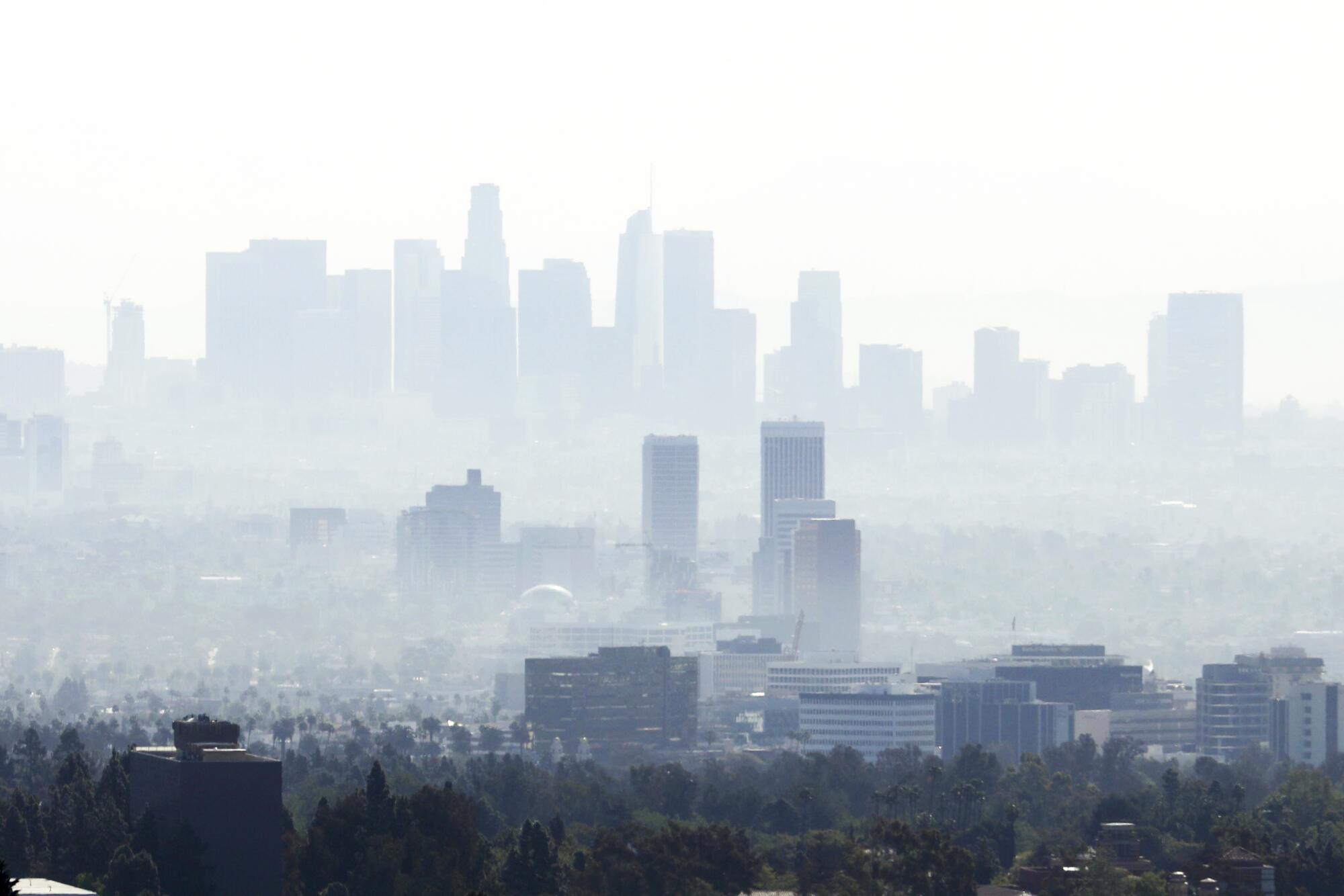
I searched for somewhere close to the pollution-clearing winds, 1,000 feet from highways, a quarter-mile from oil drilling, away from major trucking routes and railroads, and nowhere near a lead-spewing airport.
I discovered — and moved into — a one-bedroom apartment in the Palms neighborhood, far enough away from the 405 and 10 to put a buffer between me and freeway pollution.
I often march up the Culver City Stairs nearby and admire the panoramic views. In a city where smog had once limited visibility to less than three blocks, the fact that I can see the Hollywood sign, nine miles away, shows how far we’ve come.
But, on smoggy summer days, when the majestic vista of the Santa Monica Mountains looks like a half-developed photograph, it proves we still have a ways to go.
